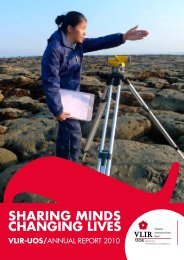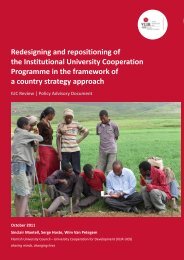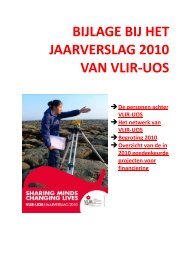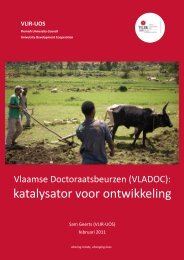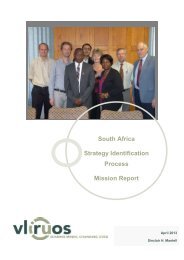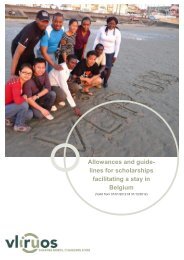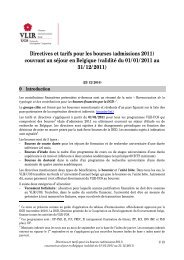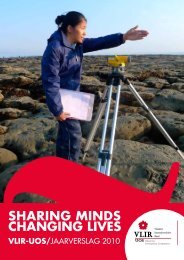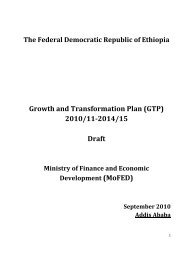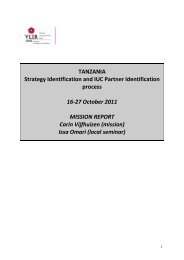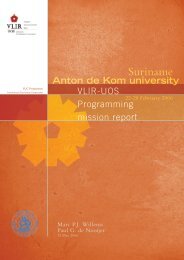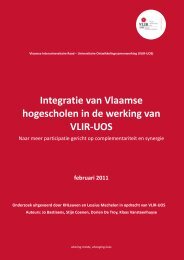Education Sector Development Program - VLIR-UOS
Education Sector Development Program - VLIR-UOS
Education Sector Development Program - VLIR-UOS
Create successful ePaper yourself
Turn your PDF publications into a flip-book with our unique Google optimized e-Paper software.
<strong>Education</strong> <strong>Sector</strong> <strong>Development</strong> <strong>Program</strong> IV<br />
achievement. More attention will be given to the<br />
quality of facilities under ESDP IV.<br />
In addition to the National Leaning Assessments<br />
being carried out every three years at grades 4, 8,<br />
10 and 12, Ethiopia will join regional/international<br />
learning assessment organizations to determine<br />
the status of quality of education as compared<br />
to other countries to ensure international<br />
competitiveness.<br />
Strengthen the focus on Sciences and<br />
Technology<br />
Achieving the vision of transforming Ethiopia<br />
into a middle-income country in 2025 demands<br />
transformation of the economy through application<br />
of science and technology as instruments to create<br />
wealth. In line with the key priorities of the current<br />
Growth and Transformation Plan, a large demand<br />
is expected for middle and high level human<br />
resources. It is therefore critically important<br />
to emphasize science and technology so as to<br />
produce capable citizens who can contribute to<br />
make the country competitive in the increasingly<br />
knowledge-based global economy. It has become<br />
mandatory for the education system to manifest<br />
overall improvement in sciences, mathematics,<br />
engineering and technology. This calls for a<br />
continued expansion and equitable access to<br />
high-quality general education with promising<br />
foundations in science and mathematics and<br />
special efforts to improve the science literacy<br />
level of the population.<br />
<strong>Education</strong> with science and mathematics as<br />
its major components determines the level of<br />
prosperity and welfare of the people and the<br />
nation. The promotion of science, mathematics,<br />
engineering and technology education (science<br />
and technology) will be visible at all levels of the<br />
education system (general education, TVET and<br />
higher education). This initiative will also call for<br />
strong inter-sectoral linkage and coordination, in<br />
particular close collaboration with the Ministry of<br />
Science and Technology.<br />
Within general education (grades 1-12), science<br />
and mathematics education is essential for<br />
cultivating a generation of scientists and for<br />
poverty reduction of the population. Greater<br />
understanding of the relevance of science and<br />
mathematics education for development is the<br />
foundation of any effort to improve science and<br />
mathematics. The purpose is to prepare students<br />
as citizens who make decisions about social<br />
issues that involve science and technology and as<br />
workers whose occupations increasingly involve<br />
science and technology.<br />
The MOE has developed a strategy of improving<br />
science and mathematics education particularly<br />
applicable to general education. Its goal is to<br />
enhance the quality of science and mathematics<br />
education and advance the performance of<br />
students. This will serve as a basis and bridge<br />
for creating a virtual link with the curricula of<br />
TVET and higher education. Hence, students<br />
will possess the necessary skills, general<br />
knowledge, awareness and problem solving<br />
competencies in sciences and mathematics<br />
when they are streamed into either TVET or the<br />
fields of engineering, technology, natural and<br />
computational science studies at advanced level<br />
in higher education.<br />
As a result, concerted efforts will be devoted<br />
under ESDP IV to enhance science and technology<br />
through introducing high quality curricula at<br />
primary and secondary schools, through<br />
efficient implementation of the TVET outcome<br />
and/or competency based strategy and<br />
through effective promotion of the policy<br />
of 70:30 higher education intake ratios in<br />
favor of science & technology.<br />
Equity in access: reaching the<br />
marginalized and unreached<br />
Notwithstanding the significant progress<br />
in access and the improvements in some<br />
equity indicators (e.g. gender parity index<br />
in primary education), participation levels<br />
at primary remain much lower in some of the<br />
emerging regions and among pastoralist and<br />
semi- pastoralist groups. Overall, about three<br />
million primary school age children are outof-school<br />
in the country. Rural populations in<br />
general face serious accessibility constraints<br />
at secondary level. Alternative Basic <strong>Education</strong><br />
has developed rapidly and has helped increase<br />
enrolment but problems of low quality and of<br />
transition between Alternative Basic <strong>Education</strong><br />
and the formal school system remain. These<br />
problems need to be addressed in order for<br />
Ethiopia to achieve Universal Primary <strong>Education</strong><br />
(UPE) and to work towards the universalization<br />
of secondary education, which are the foundation<br />
on which to build a competitive economy and a<br />
society characterized by justice and fairness.<br />
Ethiopia has implemented free primary education<br />
policies as of 1994. The high direct cost of<br />
education to parents is a reason why poor children<br />
do not enter school or drop out early. Where<br />
schools/woredas/regions decide to levy fees in a<br />
form of community contribution, they will need to<br />
ensure that arrangements are in place to ensure<br />
that no child is excluded from school because of<br />
Specific strategies will<br />
be developed to improve<br />
access to secondary<br />
education in rural areas<br />
in an affordable manner.<br />
13



